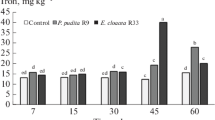Abstract
Myxobacteria presumably produce extracellular bacteriolytic enzymes when they are growing in soil. In order to study their ecological significance, adsorption experiments were performed with lytic enzymes produced byMyxococcus virescens in casitone media. Different soils as well as montmorillonite and kaolinite can rapidly adsorb the bacteriolytic but not the proteolytic enzymes. About 1 gm of montmorillonite per liter of cell-free culture solution is enough for the adsorption of 97% of the bacteriolytic enzymes. The adsorption per unit weight is about 100 times greater on montmorillonite than on kaolinite. About 40% of the adsorbed enzymes can be eluted with solutions of high pH or high ionic strength. The only desorbed bacteriolytic enzyme is the alanyl-∈-N-lysine endopeptidase.
Similar content being viewed by others
References
Albert, J. T., and R. D. Harter. 1973. Adsorption of lysozyme and ovalbumin by clay: Effect of clay suspension pH and clay mineral type.Soil Sci. 115: 130–136.
Alderton, G. W. H. Ward, and H. L. Fevold. 1945. Isolation of lysozyme from egg white.J. Biol. Chem. 157: 43–58.
Chapman, H. D. 1965. Cation-exchange capacity.In:Methods of Soil Analysis. C. A. Black, D. D. Evans, J. L. White, J. L. Ensminger, and F. E. Clark, editors. Pt. 2, pp. 891–901. Amer. Soc. Agr., Inc., Madison, Wisconsin.
Day, P. R. 1965. Particle fractionation and particle-size analysis.In:Methods in Soil Analysis. C. A. Black, D. D. Evans, J. L. White, J. L. Ensminger, and F. E. Clark, editors. Pt. 1, pp. 545–567. Amer. Soc. Agr., Inc., Madison, Wisconsin.
Dworkin, M. 1966. Biology of the myxobacteria.Ann. Rev. Microbiol. 20: 75–106.
Filip, Z. 1973. Clay minerals as a factor influencing the biochemical activity of soil microorganisms.Folia Microbiologica 18: 56–74.
Ghuysen, J. M., D. J. Tipper, and J. L. Strominger. 1966. Enzymes that degrade bacterial cell walls.In:Methods in Enzymology, S. P. Collowick and N. O. Kaplan, editors. Vol. 8, pp. 685–699. Academic Press, New York.
Harter, R. D., and G. Stotzky. 1971. Formation of clay-protein complexes.Soil Sci. Soc. Amer. Proc. 35: 383–389.
Harter, R. D. and G. Stotzky. 1973. X-ray diffraction, electron microscopy, electrophoretic mobility, and pH of some stable smectite-protein complexes.Soil Sci. Soc. Amer. Proc. 37: 116–123.
Haskå, G. 1971. Extracellular lytic enzymes ofMyxococcus virescens. I. Separation of the bacteriolytic enzymes from the bulk of proteinases.Physiol. Plant. 25: 86–89.
Haskå, G. 1972. Extracellular lytic enzymes ofMyxococcus virescens. II. Purification of three bacteriolytic enzymes and determination of their molecular weights and isoelectric points.Physiol. Plant. 26: 221–229.
Haskå, G. 1974. Extracellular lytic enzymes ofMyxococcus virescens. IV. Purification and characterization of a D-alanyl-∈-N-lysine endopeptidase.Physiol. Plant. 31:252–256.
Haskå, G. and S. Ståhl. 1971. Variants ofMyxococcus virescens exhibiting dispersed growth. Growth and production of extracellular enzymes and slime.Physiol. Plant. 24: 136–142.
McLaren, A. D. 1954a. The adsorption and reactions of enzymes and proteins on kaolinite. I.J. Phys. Chem. 58: 129–137.
McLaren, A. D. 1954b. The adsorption and reactions of enzymes and proteins on kaolinite. II. The action of chymotrypsin on lysozyme.Soil Sci. Soc. Proc. 18: 170–174.
McLaren, A. D., and E. F. Estermann. 1956. The adsorption and reactions of enzymes and proteins on kaolinite. III. The isolation of enzyme-substrate complexes.Arch. Biochem. Biophys. 61: 158–173.
McLaren, A. D., and E. F. Estermann. 1957. Influence of pH on the activity of chymotrypsin at a solid-liquid interface.Arch. Biochem. Biophys. 68: 157–160.
McLaren, A. D., G. H. Peterson, and I. Barshad. 1958. The adsorption and reactions of enzymes and proteins on clay minerals: IV. Kaolinite and montmorillonite.Soil Sci. Soc. Proc. 22: 239–244.
Stotzky, G. 1972. Activity, ecology and population dynamics of microbes in soil.Crit. Rev. Microbiol. 2: 59–137.
Yermoljeva, Z. W., and I. Bouianowskaja. 1938. Le lysozyme, ses propriétés et ses applications.Acta Medica URSS. 1: 248–257.
Östling, S., and P. Virtama. 1946. A modified preparation of the universal buffer described by Theorell and Stenhagen.Acta Phys. Scand. 11: 289–293.
Author information
Authors and Affiliations
Rights and permissions
About this article
Cite this article
Haskå, G. Influence of clay minerals on sorption of bacteriolytic enzymes. Microb Ecol 1, 234–245 (1974). https://doi.org/10.1007/BF02512391
Issue Date:
DOI: https://doi.org/10.1007/BF02512391




